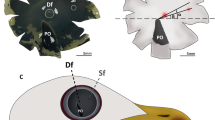Summary
1. A total of 10435 nerve cells was counted in 300 thick sections from 15 Golgi impregnated eyes and classified according to part I (Wagner, 1973).
2. The quantitative distribution of retinal neurones was also determined in Foot-Masson stained preparations of 5 different regions of the retina. Cell density was very high in the medio-temporal area whereas in the ventral part it was very low.
3. Both methods result in rather different ratios of the respective retinal neuron classes. This can be attributed to the methodical difficulties of the rapid Golgi method: cell-type-specific differences of argyrophilia, differences in ease of identification due to the various shapes of the processes of the cells, and diffusion bands as a result of block impregnation.
4. The calculations are based on the assumption that there are no differences of argyrophilia within one retinal layer, i.e. one cell class. The distribution of the neuron types can be found by combining the percentage of the silver-impregnated cell-types within one cell-class with the percentage of the cell-classes as follows from the nuclear-staining-method according to Foot-Masson. This results in the calculation of the percentage of the cell-types among all retinal neurones.
5. Within the outer plexiform layer the percentage of rods agrees with that of f-bipolar cells, and the percentage of cones corresponds to that of g- and h-bipolars.
6. In the inner plexiform layer the percentage of the stratified and diffuse amacrine cells is as high as that of the corresponding types of ganglion cells; these amacrine and ganglion cells make up the highest percentage of their respective classes.
7. The similarities in the quantitative and the spatial distributions of amacrines and ganglion cells of corresponding shape are in accordance with the findings of Vilter (1947, 1953). The functional significance is not clear.
Zusammenfassung
1. In 300 Dickschnitten von 15 silberimprägnierten Augen von Nannacara anomala wurden sämtliche Nervenzellen (insgesamt 10435) ausgezählt und nach Wagner (1973, Teil I) klassifiziert.
2. In Foot-Masson gefärbten Querschnitten wurde aus Zählungen an 5 verschiedenen Netzhautregionen die prozentuale Verteilung der Zellklassen ermittelt. In der medio-temporalen Area ergab sich dabei die dichteste und im ventralen Bereich die lockerste Zellpopulation.
3. Beide Methoden führten zu stark abweichenden Werten im prozentualen Verhältnis der Klassen der Retinaneurone. Eine Erklärung dafür liefern die methodischen Fehlerquellen der Golgi-Methode: Neuronenspezifische Unterschiede in der Argyrophilie, unterschiedliche Identifizierbarkeit aufgrund der unterschiedlichen Ausdehnung der Fortsätze und Diffusionshorizonte bei der Stückimprägnation.
4. Den Berechnungen liegt die Annahme zugrunde, daß innerhalb einer Retinaschicht, d. h. einer Zellklasse keine Unterschiede in der Argyrophilie bestehen. Die Verteilung der Neuronenarten läßt sich ermitteln, indem man das prozentuale Verhältnis der silberimprägnierten Zellarten bezogen auf jeweils eine Zellklasse in die prozentuale Verteilung der Zellklassen, wie es aus der Kernfärbung (nach Foot-Masson) hervorgeht, einsetzt. Daraus ergibt sich rechnerisch der relative prozentuale Anteil der einzelnen Zellarten innerhalb aller Retinaneurone.
5. Im Bereich der Äußeren Faserschicht (ÄFS) stimmt der prozentuale Anteil der Stäbchen (a-Zellen) mit dem der riesigen (f) Bipolaren und der Anteil der Zapfen (b- und c-Rezeptoren) mit dem der kleinen (g- und h-) Bipolaren gut überein.
6. Im Bereich der Inneren Faserschicht (IFS) sind die schichtenbildenden sowie die diffusen Amakrinen gleich häufig wie die entsprechenden Ganglienzellen; sie stellen den größten Anteil ihrer Klassen. Demgegenüber kommen asymmetrische Amakrinen sowie radiäre, einkanalige Ganglienzellen nur selten vor.
7. Gemeinsamkeiten in der quantitativen und räumlichen Verteilung von Amakrinen und Ganglienzellen, die auch in ihrer Erscheinungsform übereinstimmen, werden durch Ergebnisse von Vilter (1947, 1953) bestätigt. Ihre funktionelle Bedeutung ist unklar.
Similar content being viewed by others
Literatur
Dathe, H. H.: Vergleichende Untersuchungen an der Retina mitteleuropäischer Süßwasserfische. Z. mikr.-anat. Forsch. 80, 269–319 (1969).
Foot, N. Ch.: The Masson trichromate staining methods in routine laboratory use. Stain Technol. 3, 101–110 (1933).
Liesegang, R. E.: Untersuchungen über die Golgi-Färbung. J. Psychol. Neurol. 17, 1 (1910).
Rohen, J. W.: Funktionelle Anatomie des Nervensystems. Stuttgart: Schattauer 1971.
Schnackenbeck, W.: Pisces. Die Augen der Teleostier. In: Handb. d. Zoologie, ed. W. Kükenthal, Bd. 6, 1 u. 2, S. 955–1054. Berlin: W. de Gruyter 1960.
Vilter, V.: Dissociation spatiale des champs photo-sensoriels à cônes et à bâtonnets chez un poisson marin, le Callionymphe lyra. C. R. Soc. Biol. (Paris) 141 (1947).
Vilter, V.: Dissociation spatiale des cônes et des bâtonnets dans la rétine du Callionyme et ses relations avec l'architectonique neurale de l'appareil visuel. C. R. Soc. Biol. (Paris) 141 (1947).
Vilter, V.: Signification fonctionelle des cellules amacrines dans la rétine des vertébrés. C. R. Soc. Biol. (Paris) 147 (1953).
Wagner, H.-J.: Vergleichende Untersuchungen über das Muster der Sehzellen und Horizontalen in der Teleostier-Retina (Pisces). Z. Morph. Tiere 72, 77–130 (1972).
Wagner, H.-J.: Die nervösen Netzhautelemente von Nannacara anomala (Cichlidae, Teleostei) I. Darstellung durch Silberimprägnation. Z. Zellforsch. 137, 63–86 (1973).
Author information
Authors and Affiliations
Rights and permissions
About this article
Cite this article
Wagner, H.J. Die nervösen Netzhautelemente von Nannacara anomala (Cichlidae, Teleostei). Z.Zellforsch 137, 87–95 (1973). https://doi.org/10.1007/BF00307050
Received:
Issue Date:
DOI: https://doi.org/10.1007/BF00307050




